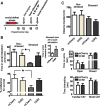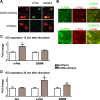Antidepressant effect of optogenetic stimulation of the medial prefrontal cortex
- PMID: 21123555
- PMCID: PMC3004756
- DOI: 10.1523/JNEUROSCI.1731-10.2010
Antidepressant effect of optogenetic stimulation of the medial prefrontal cortex
Abstract
Brain stimulation and imaging studies in humans have highlighted a key role for the prefrontal cortex in clinical depression; however, it remains unknown whether excitation or inhibition of prefrontal cortical neuronal activity is associated with antidepressant responses. Here, we examined cellular indicators of functional activity, including the immediate early genes (IEGs) zif268 (egr1), c-fos, and arc, in the prefrontal cortex of clinically depressed humans obtained postmortem. We also examined these genes in the ventral portion of the medial prefrontal cortex (mPFC) of mice after chronic social defeat stress, a mouse model of depression. In addition, we used viral vectors to overexpress channel rhodopsin 2 (a light-activated cation channel) in mouse mPFC to optogenetically drive "burst" patterns of cortical firing in vivo and examine the behavioral consequences. Prefrontal cortical tissue derived from clinically depressed humans displayed significant reductions in IEG expression, consistent with a deficit in neuronal activity within this brain region. Mice subjected to chronic social defeat stress exhibited similar reductions in levels of IEG expression in mPFC. Interestingly, some of these changes were not observed in defeated mice that escape the deleterious consequences of the stress, i.e., resilient animals. In those mice that expressed a strong depressive-like phenotype, i.e., susceptible animals, optogenetic stimulation of mPFC exerted potent antidepressant-like effects, without affecting general locomotor activity, anxiety-like behaviors, or social memory. These results indicate that the activity of the mPFC is a key determinant of depression-like behavior, as well as antidepressant responses.
Figures




Similar articles
-
Prefrontal cortical circuit for depression- and anxiety-related behaviors mediated by cholecystokinin: role of ΔFosB.J Neurosci. 2014 Mar 12;34(11):3878-87. doi: 10.1523/JNEUROSCI.1787-13.2014. J Neurosci. 2014. PMID: 24623766 Free PMC article.
-
Astrocytic Epoxyeicosatrienoic Acid Signaling in the Medial Prefrontal Cortex Modulates Depressive-like Behaviors.J Neurosci. 2019 Jun 5;39(23):4606-4623. doi: 10.1523/JNEUROSCI.3069-18.2019. Epub 2019 Mar 22. J Neurosci. 2019. PMID: 30902874 Free PMC article.
-
Differential expression of the immediate early genes c-Fos, Arc, Egr-1, and Npas4 during long-term memory formation in the context preexposure facilitation effect (CPFE).Neurobiol Learn Mem. 2018 Jan;147:128-138. doi: 10.1016/j.nlm.2017.11.016. Epub 2017 Dec 6. Neurobiol Learn Mem. 2018. PMID: 29222058 Free PMC article.
-
Interaction of basolateral amygdala, ventral hippocampus and medial prefrontal cortex regulates the consolidation and extinction of social fear.Behav Brain Funct. 2018 Mar 19;14(1):7. doi: 10.1186/s12993-018-0139-6. Behav Brain Funct. 2018. PMID: 29554926 Free PMC article.
-
Medial prefrontal and ventral hippocampal contributions to incidental context learning and memory in adolescent rats.Neurobiol Learn Mem. 2019 Dec;166:107091. doi: 10.1016/j.nlm.2019.107091. Epub 2019 Sep 19. Neurobiol Learn Mem. 2019. PMID: 31542328
Cited by
-
Effects of chronic ethanol exposure on neuronal function in the prefrontal cortex and extended amygdala.Neuropharmacology. 2015 Dec;99:735-49. doi: 10.1016/j.neuropharm.2015.06.017. Epub 2015 Jul 16. Neuropharmacology. 2015. PMID: 26188147 Free PMC article.
-
Blocking Astrocytic GABA Restores Synaptic Plasticity in Prefrontal Cortex of Rat Model of Depression.Cells. 2020 Jul 16;9(7):1705. doi: 10.3390/cells9071705. Cells. 2020. PMID: 32708718 Free PMC article.
-
Optogenetic Stimulation of Prefrontal Glutamatergic Neurons Enhances Recognition Memory.J Neurosci. 2016 May 4;36(18):4930-9. doi: 10.1523/JNEUROSCI.2933-15.2016. J Neurosci. 2016. PMID: 27147648 Free PMC article.
-
Dysconnectivity in Schizophrenia Revisited: Abnormal Temporal Organization of Dynamic Functional Connectivity in Patients With a First Episode of Psychosis.Schizophr Bull. 2023 May 3;49(3):706-716. doi: 10.1093/schbul/sbac187. Schizophr Bull. 2023. PMID: 36472382 Free PMC article.
-
EphB2 in the Medial Prefrontal Cortex Regulates Vulnerability to Stress.Neuropsychopharmacology. 2016 Sep;41(10):2541-56. doi: 10.1038/npp.2016.58. Epub 2016 Apr 22. Neuropsychopharmacology. 2016. PMID: 27103064 Free PMC article.
References
-
- Airan RD, Thompson KR, Fenno LE, Bernstein H, Deisseroth K. Temporally precise in vivo control of intracellular signalling. Nature. 2009;458:1025–1029. - PubMed
-
- Baeg EH, Kim YB, Jang J, Kim HT, Mook-Jung I, Jung MW. Fast spiking and regular spiking neural correlates of fear conditioning in the medial prefrontal cortex of the rat. Cereb Cortex. 2001;11:441–451. - PubMed
-
- Barbas H. Anatomic basis of cognitive-emotional interactions in the primate prefrontal cortex. Neurosci Biobehav Rev. 1995;19:499–510. - PubMed
Publication types
MeSH terms
Substances
Grants and funding
LinkOut - more resources
Full Text Sources
Other Literature Sources
